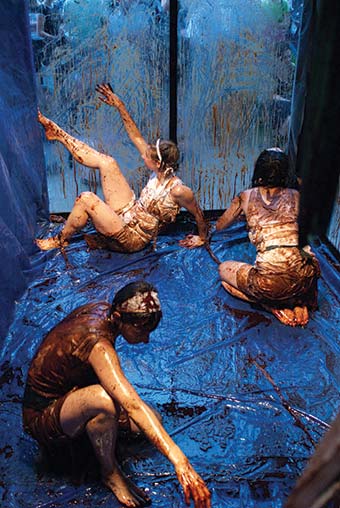Frack-U
by Geoff Kelly


Everything you ever wanted to know about fracking but were afraid to learn...
The prospect of deep-well, high-pressure, slick-water, horizontal hydrofracturing, or fracking, in New York’s Marcellus and Utican Shale formations has mobilized activists of all stripes. They’re mounting letter-writing and informational campaigns, struggling mightily to counteract a petroleum industry public relations campaign that insists that the nation’s economic and ecological health hangs on fracking for natural gas, which is peddled as a “bridge” to sustainable energy sources like wind and solar. In response, opponents point to mounting evidence that, in fact, the technique poses dangerous and costly environmental risks, is not really any cleaner than other fossil fuels, and has not proven to be the economic boon that industry has promised it would be in other states.
Still, the competing messages from environmentalists and industry are confusing. The deadline looms for public comments on New York’s proposed regulatory scheme for fracking: Monday, December 12. How’s an undecided person to form an opinion in so short a time?
If you like your education delivered with equal measures of art and activism, you might enroll in Frack-U, this Friday, December 2, 6-9pm, at Gallery 164 on Allen Street. That’s the headquarters for nimbus dance, the multidisciplinary performace troupe led by dancer Beth Elkins and architect Brad Wales.
In past performances, nimbus dance has frequently found the sweet spot between art and activism, as in the ensemble’s commentaries on BP and the Gulf oil spill radiological waste in Western New York, which combined imaginative choreography and sets with engaging (and disturbing) video, text, and spoken-word performance.
Frack-U is a collaborative effort: The nimbus dancers—Elyssa Bourke, Katherine Evans, Angela Lopez, and Elkins—will appear as cheerleaders for Frack-U, while local environmental advocates—Protecting Our Water Rights, WNY Drilling Defense, GreenWatch, Burning Books, and others—present information about the realities of fracking and its potential impacts on water and air quality, private property values, and public infrastructure. There will be letters for people to sign and post to Governor Andrew Cuomo and the New York State Department of Environmental Conservation, as well as to local state legislators, underlining the deficiencies of the DEC’s proposal to permit fracking in the Marcellus Shale. There will be materials for people to write their own letters, too.
Just a sampling of that things you might learn at Frack-U:
• New York already ranks 11th in the nation for highest overall cancer rate, yet DEC has included no public health impact studies in considering wheteher and how to permit fracking, which rleases carcinogenic chemicals into the water and the air.
• Increasingly, banks view gas leases as devaluing a property to the point of being unmortgageable.
• Despite what both industry and DEC claim, there have been documented cases of drinking water contaminated by gas drilling in New York State and around the country.
• DEC’s plan to exempt the New York City and Syracuse watersheds from gas drilling is not only absurd—how can fracking be safe in one part of the state but not in another?—but likely a violation of state and federal guarantees of equal protection under the law.
• While industry representatives argues that stronger well casing will prevent waste fluid and methane from contaminating water supplies, the fact is that fractured gas wells don’t leak from inside the well casings out, but rather from outside the well casings up—and thus into drinking water wells. Thicker, better, and even more casings won’t prevent that.
• Within five years, 25 percent of gas wells leak. Withing eight years, 40 percent of gas wells leak. “Gas wells leak,” writes James Northrup, a former gas and oil man turned anti-fracking activist. “And all of them will leak eventually.”
• Although the gas industry plans and constructs wells in clusters, the DEC proposes to issue permits for wells individually, without a plan for measuring the cumulative impacts of a cluster of wells—or, more realistically, many clusters of clusters of wells—on a single area.
• In the rush to lure investors to underwrite expensive horizontal fracking ventures in other states, gas and oil copmanies grossly overstated the potential productivity of their wells and their reserves, according to a New york Times report. One industry insider called fracking for natural gas “a Ponzi scheme,” while another said that natural gas companies “are having an Enron moment.”
Friday’s performance will include a video component comprising, among other elements, clips from Gasland, Josh Fox’s documentary about fracking across the country, in the gallery’s storefront. The video component is directed by Brian Milbrand of the Reactionary Ensemble.
FRACK-U takes place during Allentown’s monthly First Friday Gallery Walk, which is a fine reason by itself to come to Allentown, with a reprise the following Friday. The lighting of the district’s Christmas tree takes place after the first performance directly across the street from the gallery.
blog comments powered by Disqus|
Issue Navigation> Issue Index > v10n48 (Week of Thursday, December 1) > Frack-U This Week's Issue • Artvoice Daily • Artvoice TV • Events Calendar • Classifieds |









 Current Issue
Current Issue